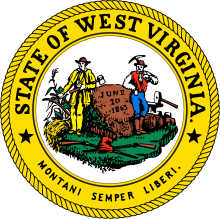Washington metropolitan area
The Washington D.C. Metropolitan Area is the metropolitan area centered on Washington, D.C., the capital of the United States. The area includes all of the federal district and parts of the U.S. states of Maryland, Virginia and West Virginia. It is part of the larger Baltimore–Washington metropolitan area.
Washington D.C. Metropolitan Area (Washington – Arlington – Alexandria) | |
|---|---|
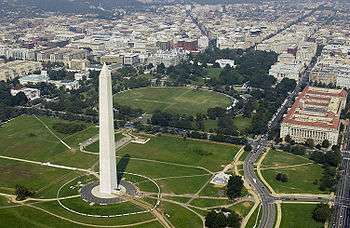 _at_Virginia_State_Route_400_(Washington_Street)_in_Alexandria%2C_Virginia.jpg) | |
| Nickname(s): | |
| Country | |
| U.S. state/federal district | Principal Subdivisions (National Capital Region):[3] |
| Principal municipalities | Washington, Arlington, Alexandria |
| Area (2010) | |
| • Urban | 1,407.0 sq mi (3,644.2 km2) |
| • Metro | 5,564.6 sq mi (14,412 km2) |
| Elevation | 0–2,350 ft (0–716 m) |
| Population | |
| • Metropolitan area | 6,133,552 (6th) |
| • Density | 1,084/sq mi (418.7/km2) |
| • Urban | 4,586,770 (8th) |
| • CSA (2010) | 9,546,579 (4th) |
| Time zone | UTC-5 (ET) |
| • Summer (DST) | UTC-4 (EST) |
The Washington D.C. metropolitan area is one of the most educated and most affluent metropolitan areas in the US.[7] The metro area anchors the southern end of the densely populated Northeast megalopolis with an estimated total population of 6,216,589 as of the 2017 U.S. Census Bureau estimate,[8] making it the sixth-largest metropolitan area in the nation[9] and the largest metropolitan area in the Census Bureau's South Atlantic division.[10]
Nomenclature
The U.S. Office of Management and Budget defines the area as the Washington–Arlington–Alexandria, DC–VA–MD–WV metropolitan statistical area, a metropolitan statistical area used for statistical purposes by the United States Census Bureau and other agencies. The region's three largest cities are the federal territory of Washington, D.C., the county (and census-designated place) of Arlington, and the independent city of Alexandria. The Office of Management and Budget also includes the metropolitan statistical area as part of the larger Baltimore–Washington metropolitan area, which has a population of 9,546,579 as of the 2014 Census Estimate.[11]
The Washington, D.C., Maryland, and Virginia[3] portions of the metropolitan area is sometimes referred to as the National Capital Region or the D.C. Area, particularly by federal agencies such as the military,[12] Department of Homeland Security,[13] and some local government agencies. The National Capital Region portion of the Washington Metropolitan Area is also colloquially known by the acronym "DMV" which stands for the "District of Columbia, Maryland, Virginia."[14] The area in the region that is surrounded by Interstate 495 referred to as being "Inside the Beltway". The city of Washington, which is at the center of the area, is referred to as "the District" because of its status as a federal district, which makes it not part of any state. The Virginian portion of the region is known as Northern Virginia and the Maryland portion of the region is sometimes called the Maryland-National Capital Region, by some local authorities but is not widely used by the general public.[15][16]
Composition
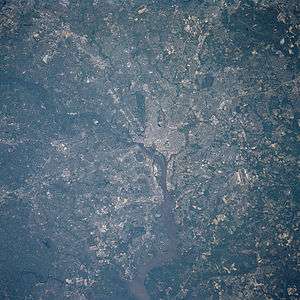
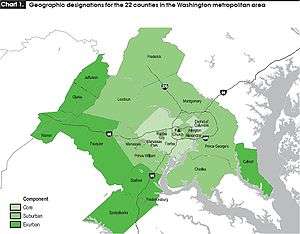
The U.S. Census Bureau divides the Washington statistical metropolitan area into two metropolitan divisions:[17]
- Washington–Arlington–Alexandria, DC–VA–MD–WV Metropolitan Division, comprising the majority of the metropolitan area
- Silver Spring–Frederick–Rockville, MD Metropolitan Division, consisting of Montgomery and Frederick counties
Political subdivisions
The area includes the following counties, districts, and independent cities:[17]
District of Columbia
Virginia
West Virginia
| Historical populations - Washington Metropolitan Area | |||
|---|---|---|---|
| Census | Pop. | %± | |
| 1950 | 1,464,089 | — | |
| 1960 | 2,001,897 | 36.7% | |
| 1970 | 2,861,123 | 42.9% | |
| 1980 | 3,060,922 | 7.0% | |
| 1990 | 3,923,574 | 28.2% | |
| 2000 | 4,923,153 | 25.5% | |
| 2010 | 5,636,232 | 14.5% | |
| Est. 2019 | 6,280,487 | 11.4% | |
| U.S. Decennial Census 2011 estimate | |||
Regional organizations
Metropolitan Washington Council of Governments
Founded in 1957, the Metropolitan Washington Council of Governments (MWCOG) is a regional organization of 21 Washington-area local governments, as well as area members of the Maryland and Virginia state legislatures, the U.S. Senate, and the U.S. House of Representatives. MWCOG provides a forum for discussion and the development of regional responses to issues regarding the environment, transportation, public safety, homeland security, affordable housing, community planning, and economic development.[18]
The National Capital Region Transportation Planning Board, a component of MWCOG, is the federally designated metropolitan planning organization for the metropolitan Washington area.[19]
Consortium of Universities in the Washington Metropolitan Area
Chartered in 1964, the Consortium of Universities of the Washington Metropolitan Area is a regional organization of 17 Washington-area local universities and community colleges representing nearly 300,000 students.[20] The consortium facilitates course cross registration between all member universities, and universalizes library access across some of its member universities through the Washington Research Library Consortium. It additionally offers joint procurement programs, joint academic initiatives, and campus public safety training.[21] These colleges and universities are:
- American University
- The Catholic University of America
- Gallaudet University
- Georgetown University
- George Mason University
- George Washington University
- Howard University
- Marymount University
- National Defense University
- National Intelligence University
- Trinity Washington University
- University of the District of Columbia
- University of Maryland, College Park
Washington Metropolitan Area Transit Authority
Formed in 1967 as an interstate compact between Maryland, Virginia, and the District of Columbia, the WMATA is a tri-jurisdictional government agency with a board composed of representatives from Maryland, Virginia, the District of Columbia, and the United States Federal government that operates transit services in the Washington Metropolitan Area.
Metropolitan Washington Airports Authority
The Metropolitan Washington Airports Authority (MWAA) is a multi-jurisdictional independent airport authority, created with the consent of the United States Congress and the legislature of Virginia to oversee management, operations, and capital development of Ronald Reagan Washington National Airport and Washington Dulles International Airport.[22]
Greater Washington Board of Trade
Founded in 1889, the Greater Washington Board of Trade is a network of regional businesses that work to advance the culture, economy, and resiliency of the Washington metropolitan area.[23]
Cultural Alliance of Greater Washington
The Cultural Alliance of Greater Washington (CAGW) works to increase appreciation, support, and resources for arts and culture in the Greater Washington DC region.
Principal cities
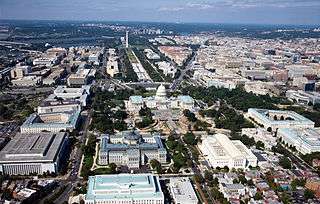
The metropolitan area includes the following principal cities (not all of which are incorporated as cities; one, Arlington, is actually a county, and Bethesda, Reston, and Silver Spring are unincorporated CDPs.)[17]
Demographics
| Year | DEM | GOP | Others |
|---|---|---|---|
| 2016 | 69.0% 1,860,678 | 25.7% 692,743 | 5.4% 145,269 |
| 2012 | 67.5% 1,813,963 | 30.9% 829,567 | 1.7% 44,708 |
| 2008 | 68.0% 1,603,902 | 31.0% 728,916 | 1.0% 25,288 |
| 2004 | 61.0% 1,258,743 | 38.0% 785,144 | 1.4% 19,735 |
| 2000 | 58.5% 1,023,089 | 37.9% 663,590 | 3.6% 62,437 |
| 1996 | 57.0% 861,881 | 37.0% 558,830 | 6.0% 89,259 |
| 1992 | 53.0% 859,889 | 34.1% 553.369 | 12.9% 209,651 |
| 1988 | 50.4% 684,453 | 48.6% 659,344 | 1.0% 14,219 |
| 1984 | 51.0% 653,568 | 48.5% 621,377 | 0.4% 5,656 |
| 1980 | 44.7% 484,590 | 44.6% 482,506 | 11.1% 115,797 |
| 1976 | 54.2% 590,481 | 44.9% 488,995 | 1.0% 10,654 |
| 1972 | 44.2% 431,257 | 54.8% 534,235 | 1.1% 10,825 |
| 1968 | 49.4% 414,345 | 39.1% 327,662 | 11.5% 96,701 |
| 1964 | 69.8% 495,490 | 30.2% 214,293 | 0.1% 462 |
| 1960 | 52.5% 204,614 | 47.3% 184,499 | 0.1% 593 |
.jpg)
Old Town Alexandria, Joint Base Anacostia-Bolling, and National Harbor, Maryland are visible.
Politics
The relative strength of the major political parties within the region is shown by the presidential election results since 1960, as presented in the adjacent table.
Racial composition
The area has been a magnet for international immigration since the late 1960s. It is also a magnet for internal migration (persons moving from one region of the U.S. to another).[24]
Racial composition of the Washington, D.C. area:
2016 American Community Survey
- Non-Hispanic White : 45.8%
- Black or African American : 24.9%
- Hispanic or Latino : 15.5%
- Asian : 10.0%
- Mixed and Other : 3.8%
Hispanic Origin Asian Origin 5.2% Salvadoran 2.7% Indian 2.3% Mexican 1.8% Chinese 1.2% Honduran 1.3% Korean 1.1% Guatemalan 1.2% Vietnamese 0.9% Puerto Rican 1.0% Filipino 0.8% Peruvian 0.5% Pakistani 0.7% Bolivian 0.2% Japanese 0.5% Colombian 0.2% Thai 0.4% Dominican 0.2% Bangladeshi 2.4% Other 1.0% Other
1980
- White : 67.8%
- Black : 26.0%
- Asian : 2.5%
- Hispanic : 2.8%
- Mixed and Other : 0.9%
Social indicators
The Washington metropolitan area has ranked as the highest-educated metropolitan area in the nation for four decades.[26] As of the 2006–2008 American Community Survey, the three most educated places with 200,000 people or more in Washington–Arlington–Alexandria by bachelor's degree attainment (population 25 and over) are Arlington, Virginia (68.0%), Fairfax County, Virginia (58.8%), and Montgomery County, Maryland (56.4%).[27] Forbes magazine stated in its 2008 "America's Best- And Worst-Educated Cities" report: "The D.C. area is less than half the size of L.A., but both cities have around 100,000 Ph.D.'s."[28]
The Washington, D.C. metro area has held the top spot in the American College of Sports Medicine's annual American Fitness Index ranking of the United States' 50 most populous metropolitan areas for two years running. The report cites, among other things, the high average fitness level and healthy eating habits of residents, the widespread availability of health care and facilities such as swimming pools, tennis courts, and parks, low rates of obesity and tobacco use relative to the national average, and the high median household income as contributors to the city's community health.[29]
.jpg)
In the 21st century, the Washington metropolitan area has overtaken the San Francisco Bay Area as the highest-income metropolitan area in the nation.[7] The median household income of the region is US$72,800. The two highest median household income counties in the nation – Loudoun and Fairfax County, Virginia – are components of the MSA (and #3 is Howard County, officially in Baltimore's sphere but strongly connected with Washington's); measured in this way, Alexandria ranks 10th among municipalities in the region – 11th if Howard is included – and 23rd in the entire United States. 12.2% of Northern Virginia's 881,136 households, 8.5% of suburban Maryland's 799,300 households, and 8.2% of Washington's 249,805 households have an annual income in excess of $200,000, compared to 3.7% nationally.[31]
According to a report by the American Human Development Project, women in the Washington metropolitan area are ranked as having the highest income and educational attainment among the 25 most populous metropolitan areas in the nation, while Asian American women in the region had the highest life expectancy, at 92.3 years.[32]
Counties and populations
| County | 2016 Estimate | 2010 Census | Change | Area | Density |
|---|---|---|---|---|---|
| Washington, D.C. | 681,170 | 601,723 | +13.20% | 61.05 sq mi (158.1 km2) | 11,158/sq mi (4,308/km2) |
| Calvert County, Maryland | 91,251 | 88,737 | +2.83% | 213.15 sq mi (552.1 km2) | 428/sq mi (165/km2) |
| Charles County, Maryland | 157,705 | 146,551 | +7.61% | 457.75 sq mi (1,185.6 km2) | 345/sq mi (133/km2) |
| Frederick County, Maryland | 247,591 | 233,385 | +6.09% | 660.22 sq mi (1,710.0 km2) | 375/sq mi (145/km2) |
| Montgomery County, Maryland | 1,043,863 | 971,777 | +7.42% | 491.25 sq mi (1,272.3 km2) | 2,125/sq mi (820/km2) |
| Prince George's County, Maryland | 908,049 | 863,420 | +5.17% | 482.69 sq mi (1,250.2 km2) | 1,881/sq mi (726/km2) |
| Alexandria, Virginia | 155,810 | 139,966 | +11.32% | 15.03 sq mi (38.9 km2) | 10,367/sq mi (4,003/km2) |
| Arlington County, Virginia | 230,050 | 207,627 | +10.80% | 25.97 sq mi (67.3 km2) | 8,858/sq mi (3,420/km2) |
| Clarke County, Virginia | 14,374 | 14,034 | +2.42% | 176.18 sq mi (456.3 km2) | 82/sq mi (32/km2) |
| Culpeper County, Virginia | 50,083 | 46,689 | +7.27% | 379.23 sq mi (982.2 km2) | 132/sq mi (51/km2) |
| Fairfax County, Virginia | 1,138,652 | 1,081,726 | +5.26% | 390.97 sq mi (1,012.6 km2) | 2,912/sq mi (1,124/km2) |
| Fairfax City, Virginia | 24,164 | 22,565 | +7.09% | 6.24 sq mi (16.2 km2) | 3,872/sq mi (1,495/km2) |
| Falls Church, Virginia | 14,014 | 12,332 | +13.64% | 2.00 sq mi (5.2 km2) | 7,007/sq mi (2,705/km2) |
| Fauquier County, Virginia | 69,069 | 65,203 | +5.93% | 647.45 sq mi (1,676.9 km2) | 107/sq mi (41/km2) |
| Fredericksburg, Virginia | 28,297 | 24,286 | +16.52% | 10.44 sq mi (27.0 km2) | 2,710/sq mi (1,047/km2) |
| Loudoun County, Virginia | 385,945 | 312,311 | +23.58% | 515.56 sq mi (1,335.3 km2) | 749/sq mi (289/km2) |
| Manassas, Virginia | 41,483 | 37,821 | +9.68% | 9.88 sq mi (25.6 km2) | 4,199/sq mi (1,621/km2) |
| Manassas Park, Virginia | 15,915 | 14,273 | +11.50% | 2.53 sq mi (6.6 km2) | 6,291/sq mi (2,429/km2) |
| Prince William County, Virginia | 455,210 | 402,002 | +13.24% | 336.40 sq mi (871.3 km2) | 1,353/sq mi (522/km2) |
| Rappahannock County, Virginia | 7,388 | 7,373 | +0.20% | 266.23 sq mi (689.5 km2) | 28/sq mi (11/km2) |
| Spotsylvania County, Virginia | 132,010 | 122,397 | +7.85% | 401.50 sq mi (1,039.9 km2) | 329/sq mi (127/km2) |
| Stafford County, Virginia | 144,361 | 128,961 | +11.94% | 268.96 sq mi (696.6 km2) | 537/sq mi (207/km2) |
| Warren County, Virginia | 39,155 | 37,575 | +4.20% | 213.47 sq mi (552.9 km2) | 183/sq mi (71/km2) |
| Total | 6,131,977 | 5,636,232 | +8.80% | 5,564.6 sq mi (14,412 km2) | 1,102/sq mi (425/km2) |
Economy
The Washington, D.C. area has the largest science and engineering work force of any metropolitan area in the nation in 2006 according to the Greater Washington Initiative at 324,530, ahead of the combined San Francisco Bay Area work force of 214,500, and Chicago metropolitan area at 203,090, citing data from U.S. Census Bureau, the Bureau of Labor Statistics, Claritas Inc., and other sources.[7]
The Washington, D.C. area was ranked as the second best High-Tech Center in a statistical analysis of the top 100 Metropolitan areas in the United States by American City Business Journals in May 2009, behind the Silicon Valley and ahead of the Boston metropolitan area.[35] Fueling the metropolitan area's ranking was the reported 241,264 tech jobs in the region, a total eclipsed only by New York, Los Angeles, and the San Francisco Bay Area, as well as the highest master's or doctoral degree attainment among the 100 ranked metropolitan areas.[35] A Dice.com report showed that the Washington–Baltimore area had the second-highest number of tech jobs listed: 8,289, after the New York metro area with 9,195 jobs.[36]
Real estate and housing market
Changes in house prices for the D.C. area are publicly tracked on a regular basis using the Case–Shiller index; the statistic is published by Standard & Poor's and is also a component of S&P's 10-city composite index of the value of the U.S. residential real estate market.
McLean ZIP code 22102 had the highest median home prices among ZIP codes within the Washington metropolitan area as of 2013.[37]
Net worth, wealth disparities, and business ownership
The economy of the Washington metropolitan region is characterized by significant wealth disparities, which were heightened by the Great Recession and the 2007–09 housing crisis, which adversely affected black and Hispanic households more than other households.[38][39]
A 2016 Urban Institute report found that the median net worth (i.e., assets minus debt) for white households in the D.C. region was $284,000, while the median net worth for Hispanic/Latino households was $13,000, and for African American households as $3,500.[38][39] Asian Americans had the highest median net worth in the Washington area ($220,000 for Chinese American households, $430,000 for Vietnamese American households, $496,000 for Korean American households, and $573,000 for Indian American households).[38][39]
Although the median net worth for white D.C.-area households was 81 times that of black D.C.-area households, the two groups had comparable rates of business ownership (about 9%). The Urban Institute report suggests that this "may be driven by the presence of a large federal government and a local district government whose membership and constituents have been largely Black, coupled with government policies designed to increase contracting opportunities for minority-owned businesses."[38][39]
Primary industries

Biotechnology
The Washington metropolitan area has a significant biotechnology industry; companies with a major presence in the region as of 2011 include Merck, Pfizer, Human Genome Sciences, Martek Biosciences, and Qiagen.[40] Additionally, many biotechnology companies such as United Therapeutics, Novavax, Emergent BioSolutions, and MedImmune have headquarters in the region. The area's medical research is also driven by government and non-profit health institutions, such as the Howard Hughes Medical Institute and the National Institutes of Health.
Defense contracting
Many defense contractors are based in the region to be close to the Pentagon in Arlington. Local defense contractors include Lockheed Martin, the largest, as well as General Dynamics, BAE Systems, Northrup Grumman,[41] Computer Sciences Corporation (CSC), Science Applications International Corporation (SAIC), CACI, ManTech International, DynCorp, and Leidos.
Hospitality
The Washington D.C. area contains the headquarters of numerous companies in the hospitality and hotel industries. Major companies with headquarters in the region include Marriott International, The Ritz-Carlton Hotel Company, Hilton Worldwide, Park Hotels and Resorts, Choice Hotels, Host Hotels and Resorts, and HMSHost.
Telecommunications
Anchored by the Dulles Technology Corridor, the telecommunications and tech industry in DC spans a diverse range of players across internet infrastructure, broadcasting, satellite communications, and datacenters. Firms headquartered in the area include Cogent Communications, GTT Communications, Hughes Network Systems, iCore Networks, Iridium Communications, Intelsat, Ligado Networks, NII Holdings, Oceus Networks, OneWeb, Tegna Inc., Transaction Network Services, Verisign, WorldCell, XO Communications, and XTAR.
Tourism
Tourism is a significant industry in the Washington metropolitan region. In 2015, more than 74,000 tourism-sector jobs existed in the District of Columbia, a record-setting 19.3 million domestic tourists visited the city, and domestic and international tourists combined spent $7.1 billion.[42][43] The convention industry is also significant; in 2016, D.C. hosted fifteen "city-wide conventions" with an estimated total economic impact of $277.9 million.[42]
Tourism is also significant outside the District of Columbia; in 2015, a record-setting $3.06 billion in tourism spending was reported in Arlington, Virginia, and $2.9 billion in Fairfax County, Virginia.[44] A 2016 National Park Service report estimated that there were 56 million visitors to national parks in the National Capital Region, sustaining 16,917 and generating close to $1.6 billion in economy impact.[45]
Largest companies
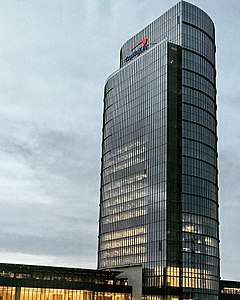
| Company | Industry | Headquarters | National rank |
|---|---|---|---|
| AES Corporation | Energy | Arlington, Virginia | 214 |
| Booz Allen Hamilton | Consulting | McLean, Virginia | 482 |
| Capital One | Finance | McLean, Virginia | 101 |
| Danaher Corporation | Conglomerate | Washington, D.C. | 162 |
| DXC Technology | Information technology | Tysons, Virginia | 374 |
| Discovery Communications | Mass media | Silver Spring, Maryland | 409 |
| Fannie Mae | Finance | Washington, D.C. | 21 |
| Freddie Mac | Finance | McLean, Virginia | 38 |
| General Dynamics | Defense | Falls Church, Virginia | 99 |
| Hilton Hotels Corporation | Hospitality | McLean, Virginia | 324 |
| Leidos | Defense | Reston, Virginia | 292 |
| Lockheed Martin | Defense | Bethesda, Maryland | 59 |
| Marriott International | Hospitality | Bethesda, Maryland | 127 |
| Northrop Grumman | Defense | Falls Church, Virginia | 118 |
| NVR, Inc. | Construction | Reston, Virginia | 444 |
| Company | Industry | Headquarters | National rank |
|---|---|---|---|
| BrightView | Landscaping | Rockville, Maryland | 220 |
| Carahsoft | Defense | Reston, Virginia | 161 |
| Clark Construction | Construction | Bethesda, Maryland | 102 |
| Mars, Incorporated | Food processing | McLean, Virginia | 7 |
History

The 2005 Base Realignment and Closure resulted in a significant shuffling of military, civilian, and defense contractor employees in the Washington, D.C., area. The largest individual site impacts of the time are as follows:[49]
- Fort Belvoir gained 11,858 employees, primarily as a result of the relocation of the National Geospatial-Intelligence Agency (NGA) into a massive new headquarters within the fort.
- Fort Meade gained 5,361 employees, primarily as a result of the expansion of the National Security Agency.
- Walter Reed Army Medical Center lost 5,630 employees as part of its realignment. It was later closed and consolidated into Walter Reed National Military Medical Center.
BRAC 2005 was the largest infrastructure expansion by the Army Corps of Engineers since World War II, resulting in the Mark Center, tallest building they have ever constructed, as well as National Geospatial-Intelligence Agency Campus East, which at 2.4 million square feet is the largest building the Corps have constructed since the Pentagon.[50]
Transportation

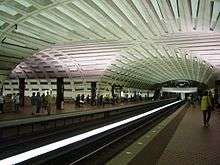
'WMATA'-indicated systems are run by Washington Metropolitan Area Transit Authority and always accept Washington Metro fare cards, others may or may not.
Major airports
- Washington Dulles International Airport (IAD), located in Dulles, Virginia
- Ronald Reagan Washington National Airport (DCA), located in Arlington County, Virginia – the closest to Washington
- Baltimore–Washington International Thurgood Marshall Airport (BWI), located in Linthicum, Maryland (outside of but serving the Washington metropolitan area)
Rail transit systems
- Washington Metro – DC, MD, VA (rapid transit) (WMATA)
- MARC Train – DC, MD, WV (commuter rail)
- Virginia Railway Express – DC, VA (commuter rail)
- Amtrak – US (commuter rail, inter-city rail)
Bus transit systems
- DC Circulator – Washington, D.C. (DDoT, WMATA)
- Metrobus – Washington metropolitan area (WMATA)
- Metroway – Arlington County, Virginia and Alexandria, Virginia (bus rapid transit) (WMATA)
- Ride On – Montgomery County, Maryland
- TheBus – Prince George's County, Maryland
- ART – Arlington County, Virginia
- DASH – Alexandria, Virginia
- Fairfax Connector – Fairfax County, Virginia
- CUE Bus – Fairfax, Virginia
- Loudoun County Transit – Loudoun County, Virginia
- PRTC – Prince William County, Manassas and Manassas Park
- TransIT – Frederick County, Maryland
- Regional Transportation Agency of Central Maryland – Howard County, Anne Arundel County, Prince George's County, Laurel, Maryland
- Maryland Transit Administration – Washington, D.C., Montgomery County, Maryland, Prince George's County, Frederick County, Maryland, Charles County, Maryland, Calvert County, Maryland, Howard County, Anne Arundel County, Saint Mary's County, Maryland
- Eastern Panhandle Transit Authority – Jefferson County, West Virginia, Berkeley County, West Virginia
- Virginia Regional Transit – Loudoun County, Virginia, Culpeper County, Virginia, Fauquier County, Virginia, Warren County, Virginia
- Fredericksburg Regional Transit – Fredericksburg, Spotsylvania County and Stafford County
Major roads
Interstates
Bicycle sharing
- Capital Bikeshare – Washington, D.C., Arlington, Virginia, Alexandria, Virginia, Fairfax County, Virginia, Prince George's County, Maryland, and Montgomery County, Maryland
Culture
Sports teams
Listing of the professional sports teams in the Washington metropolitan area:
- National Basketball Association (NBA)
- Major League Baseball (MLB)
- National Football League (NFL)
- National Hockey League (NHL)
- Major League Soccer (MLS)
- Women's National Basketball Association (WNBA)
- Atlantic League of Professional Baseball (ALPB)
- XFL
- National Women's Soccer League (NWSL)
- NBA G League
- USL Championship
Media
The Washington metropolitan area is home to USA Today, C-SPAN, PBS, NPR, POLITICO, BET, TV One and Discovery Communications. The two main newspapers are The Washington Post and The Washington Times. Local television channels include WRC-TV 4 (NBC), WTTG 5 (FOX), WJLA 7 (ABC), WUSA 9 (CBS), WDCA 20 (MyNetworkTV), WETA-TV 26 (PBS), WDCW 50 (CW), and WPXW 66 (Ion). WJLA 24/7 News is a local news provider available only to cable subscribers. Radio stations serving the area include: WETA-FM, WIHT, WSBN, and WTOP.
Area codes
- 202 – Washington, D.C.
- 571/703 – Northern Virginia including the cities of Alexandria, Fairfax, and Falls Church as well as Arlington, Fairfax, Stafford, Prince William, and Loudoun counties (571 created March 1, 2000; 703 in October 1947).
- 240/301 – portions of Maryland in the Greater Washington, D.C., metro area, southern Maryland, and western Maryland
- 540 – Fredericksburg/Spotsylvania/Warrenton
- 304/681 – Jefferson County, West Virginia
Sister cities
| City | Country | Year |
|---|---|---|
| Washington, D.C. | ||
| Bangkok | 1962, renewed 2002 | |
| Dakar | 1980, renewed 2006 | |
| Beijing | 1984, renewed 2004 | |
| Brussels | 1985, renewed 2012 | |
| Athens | 2000 | |
| Paris[Note 1] | 2000, renewed 2005 | |
| Pretoria | 2002, renewed 2008 | |
| Seoul | 2006 | |
| Accra | 2006 | |
| Sunderland | 2006 | |
| Rome | Italy | (2011, renewed 2013)[51] |
| Ankara | Turkey | (2011) |
| Brasília | Brazil | (2013) |
| Addis Ababa | Ethiopia | (2013)[52] |
| San Salvador | El Salvador | (2018) |
| Alexandria, Virginia[53] | ||
| Gyumri | ||
| Helsingborg | ||
| Dundee[Note 2] | ||
| Caen | ||
| Arlington County, Virginia[54] | ||
| Aachen | ||
| Reims | ||
| San Miguel | ||
| Coyoacán | ||
| Ivano-Frankivsk[Note 3] | ||
| Herndon, Virginia | ||
| Runnymede[Note 4] | ||
| Fairfax County, Virginia | ||
| Harbin[Note 5] | 2009 | |
| Songpa-gu[Note 6] | 2009 | |
| Falls Church, Virginia | ||
| Kokolopori[55] | 2006 | |
| District Heights, Maryland | ||
| Mbuji-Mayi[56] | 2008 | |
| Frederick, Maryland | ||
| Aquiraz | ||
| Moerzheim | ||
| Schifferstadt | ||
| La Plata, Maryland | ||
| Jogeva County | ||
| Walldorf | ||
| Rockville, Maryland | ||
| Pinneberg |
- Paris is a "Partner City" due to the one Sister City policy of that commune.
- "Historic Alexandria | City of Alexandria, VA". Oha.alexandriava.gov. Retrieved November 19, 2012.
- Exploration phase
- Town twin Archived February 12, 2006, at the Wayback Machine
- Rejected by Washington due to not being a national capital.
- "Sisterhood Partnerships". Fairfaxcounty.gov. Archived from the original on March 21, 2016. Retrieved November 19, 2012.
See also
- List of people from the Washington, D.C. metropolitan area
- List of U.S. metropolitan statistical areas in Virginia
- Potomac primary
- Northeast megalopolis
References
- "After initial obscurity, 'The DMV' nickname for Washington area picks up speed". Washington Post. July 30, 2010.
- Yager, Jane (July 30, 2010). "Nation's Capitol Now Known as 'the DMV'". Newser. Retrieved March 11, 2016.
- https://www.ncpc.gov/maps/national-capital-region/
- "Annual Estimates of the Resident Population: April 1, 2010 to July 1, 2016: MSA". 2016 Population Estimates. United States Census Bureau, Population Division. March 2016. Archived from the original on February 13, 2020. Retrieved March 6, 2018.
- "Annual Estimates of the Resident Population: April 1, 2010 to July 1, 2016: CSA". 2016 Population Estimates. United States Census Bureau, Population Division. March 2016. Archived from the original on February 13, 2020. Retrieved March 6, 2018.
- "Census Urban Area List". United States Census Bureau. 2010. Retrieved March 6, 2018.
- "Washington area richest, most educated in US: report". Washingtonpost.com. June 8, 2006. Retrieved November 19, 2012.
- Clabaugh, Jeff (March 22, 2018). "Washington metro population climbs to 6.2 million". WTOP News. Retrieved January 28, 2019.
- "Four Texas Metro Areas Collectively Add More Than 400,000 People in the Last Year, Census Bureau Reports". United States Census Bureau.
- "Census Bureau Regions and Divisions with State FIPS Codes" (PDF). US Census Bureau. Retrieved August 30, 2018.
- "U.S. Census website". United States Census Bureau. Retrieved March 26, 2015.
- "Archived copy". Archived from the original on May 10, 2016. Retrieved April 30, 2016.CS1 maint: archived copy as title (link)
- "National Capital Region – Office of National Capital Region Coordination". Department of Homeland Security. December 21, 2005. Archived from the original on December 12, 2007. Retrieved January 9, 2008.
- Cohen, Matt. "The Answers Issue 2017". Washington City Paper. Retrieved June 18, 2019.
- https://www.mders.org/
- https://www.mncppc.org/27/About-Us
- "Revised Delineations of Metropolitan Statistical Areas, Micropolitan Statistical Areas, and Combined Statistical Areas, and Guidance on Uses of the Delineations of These Areas" (PDF). Office of Management and Budget. February 20, 2013. Archived from the original (PDF) on April 18, 2013. Retrieved May 9, 2013.
- "About Us". MWCOG.org. Retrieved November 19, 2012.
- "– Transportation – TPB". Mwcog.org. Retrieved November 19, 2012.
- "AUC Partners with Consortium of Universities of the Washington Metropolitan Area | The American University in Cairo". The American University in Cairo. June 9, 2019. Retrieved July 17, 2020.
- "– Consortium – CUWMA". consortium.org. Retrieved June 17, 2019.
- "Metropolitan Washington Airports Authority". Legislative Information System. Commonwealth of Virginia. Retrieved August 14, 2019.
- Clarke, Craig (April 28, 2006). "Module Introduction & Document List: Washington Board of Trade". Washington D.C. History Matters. Retrieved June 25, 2019.
- Frey, William H. (February 2002). "Metro Magnets for Minorities and Whites: Melting Pots, the New Sunbelt, and the Heartland" (PDF). Population Studies Center at the University of Michigan. Retrieved November 19, 2012.
- "Annual Estimates of the Resident Population by Sex, Race Alone and Hispanic or Latino Origin for Counties: April 1, 2000 to July 1, 2006". Archived from the original on June 10, 2010. Retrieved January 12, 2016.
- de Vise, Daniel (July 15, 2010). "Washington region ranks as the best-educated in the country". Washingtonpost.com. Retrieved November 19, 2012.
- "2006–2008 American Community Survey 3-Year Estimates". United States Census Bureau. Retrieved November 19, 2012.
- Zumbrun, Joshua (November 24, 2008). "America's Best- And Worst-Educated Cities". Forbes.com. Retrieved November 19, 2012.
- "Washington, DC (Washington–Arlington–Alexandria, DC–VA–MD–WV MSA) 2010 AFI Report" (PDF). Archived from the original (PDF) on August 12, 2011. Retrieved May 26, 2010.
- "Macerich Tysons Corner Center Market Profile" (PDF). Archived from the original (PDF) on September 3, 2013.
- "ACS 2005–2007". United States Census Bureau. Retrieved November 19, 2012.
- "Women'S Well-Being" (PDF). Retrieved November 19, 2012.
- Downey, Kirstin (May 6, 2007). "High-Rises Approved That Would Dwarf D.C". Washingtonpost.com. Retrieved November 19, 2012.
- "List of tallest buildings in DC, MD, VA, WV". Skyscraperpage.com. Retrieved November 19, 2012.
- "The top 100 tech centers". Bizjournals. May 11, 2009. Archived from the original on February 16, 2010. Retrieved March 3, 2010.
- Nathan Eddy (March 13, 2012). "Tech Jobs Flourish in Silicon Valley, but Other Regions Offer Opportunities: Dice Report". Eweek.com. Retrieved November 19, 2012.
- Brennan, Morgan. "America's Most Expensive Zip Codes In 2013: The Complete List". Forbes. Archived from the original on March 4, 2016.
- Perry Stein, Net worth of white households in D.C. region is 81 times that of black households,Washington Post (November 2, 2016).
- Kilolo Kijakazi et al., The Color of Wealth in the Nation's Capital, Urban Institute (October 31, 2016).
- Renee Winsky & Mark Herzog, Maryland, Virginia biotech industries take center stage in D.C., Washington Business Journal (June 28, 2011).
- Censer, Marjorie (July 30, 2010). "Defense firm Northrop Grumman's second-quarter profit rose nearly 81 percent". The Washington Post.
- Perry Stein, D.C. breaks tourist record in 2015 with visitors spending $7.1 billion, Washington Post (May 3, 2016).
- Ben Nuckols, DC sets record with more than 2 million foreign tourists, Associated Press (August 24, 2016).
- Arlington County Sets Tourism Spending Record with $3 Billion, CBS Washington (September 19, 2016).
- Tourism at national parks in the Greater Washington area generates almost $1.6 billion in economic benefit (press release), National Park Service (April 21, 2016).
- "Positive review for Capital One's massive headquarters in Tysons". American City Business Journals.
- "Fortune 500". Fortune.com. Retrieved December 4, 2018.
- "America's Largest Private Companies". Forbes. Retrieved June 24, 2017.
- Appendix C BRAC 2005 Closure and Realignment Impacts by State
- Justin Matthew Ward (September 14, 2011). "BRAC 2005: on time, on budget in Northeast". army.mil.
- "Twinning with Rome". Ville de Paris. Archived from the original on June 8, 2011. Retrieved February 21, 2010.
- "DC & Addis to Become Sister Cities". Tadias Magazine. Retrieved December 6, 2013.
- "Code of Ordinances of the City of Alexandria, Virginia (Title 1, Chapter 2, Sec. 1-2-1)". City Council, City of Alexandria, Virginia. June 26, 2019. Retrieved July 10, 2019.
- "Interactive City Directory". Archived from the original on October 4, 2016. Retrieved May 7, 2016.
- "Kokolopori-Falls Church Sister City Partnership". City of Falls Church. Archived from the original on July 16, 2011. Retrieved May 8, 2012.
- McGill, Natalie (April 24, 2008). "District Heights, Congo city form relationship". The Gazette. Gaithersburg, Md. Archived from the original on September 28, 2013.
External links
| Wikivoyage has a travel guide for Washington, D.C. area. |
- OMB Bulletin No. 05-02
- Urban Areas of Virginia
- May 2006 Metropolitan and Nonmetropolitan Area Occupational Employment and Wage Estimates; Washington–Arlington–Alexandria, DC–VA–MD–WV Metropolitan Division
- May 2005 Metropolitan Area Occupational Employment and Wage Estimates; Washington–Arlington–Alexandria, DC–VA–MD–WV Metropolitan Division
- Washington–Arlington–Alexandria, DC–VA–MD–WV MSA Population and Components of Change
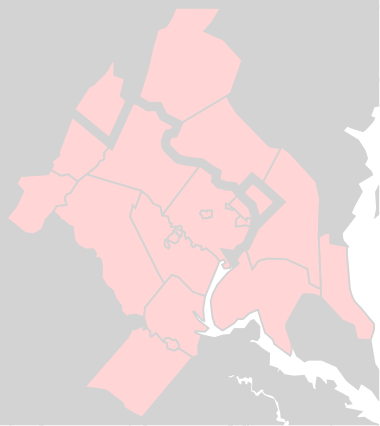
.jpg)




.svg.png)
